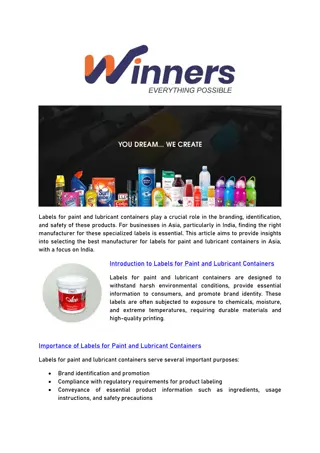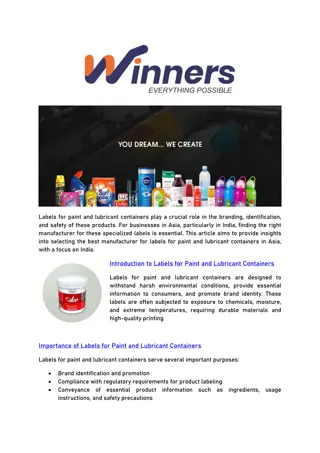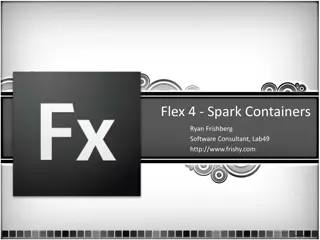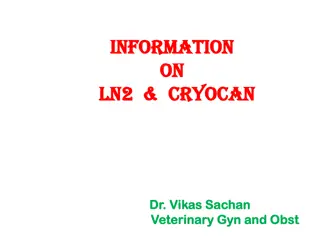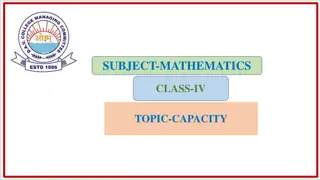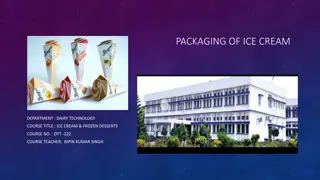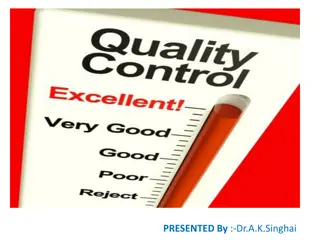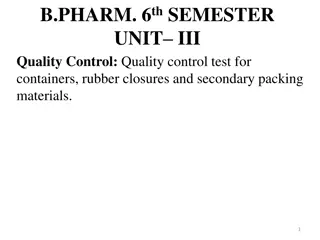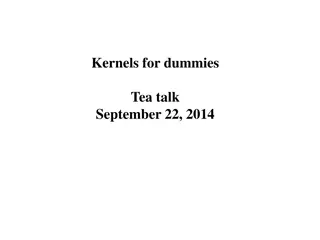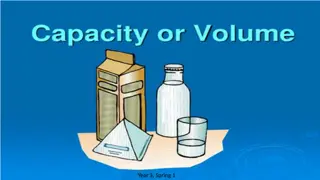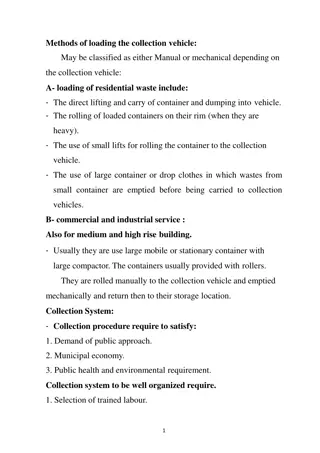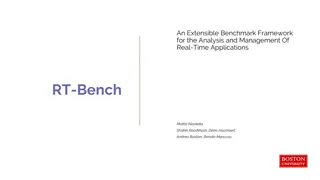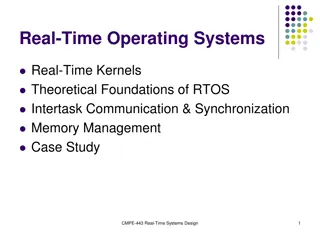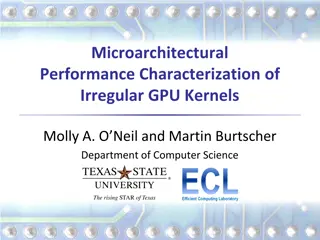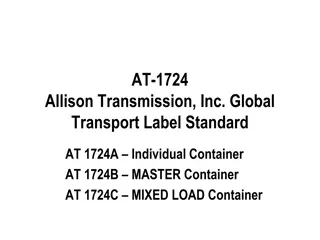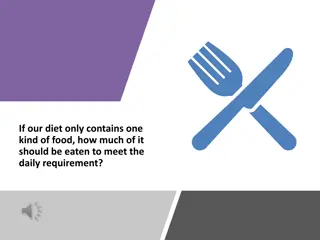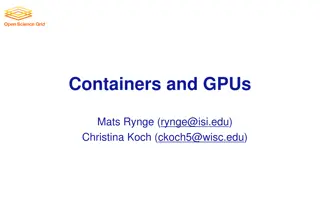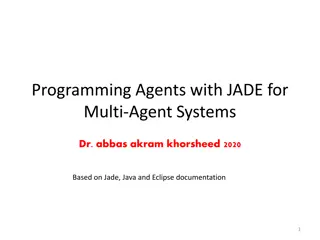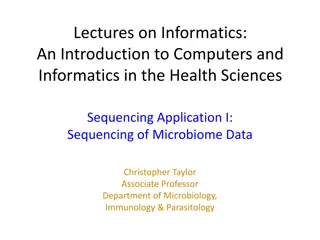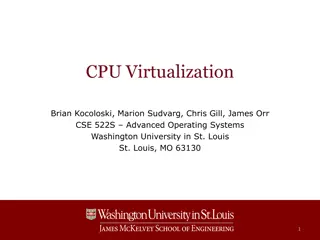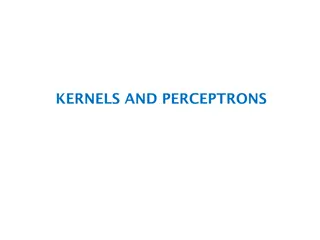Exploring Extensible Kernels and Containers in Modern Systems
"Discover the motivation behind extensible kernels and containers in modern systems, highlighting the shortcomings of monolithic kernels and the innovative solutions proposed by researchers. Explore the potential for increased performance, security, and customization through new approaches to operating system design."
Download Presentation

Please find below an Image/Link to download the presentation.
The content on the website is provided AS IS for your information and personal use only. It may not be sold, licensed, or shared on other websites without obtaining consent from the author. Download presentation by click this link. If you encounter any issues during the download, it is possible that the publisher has removed the file from their server.
E N D
Presentation Transcript
1 MODERN SYSTEMS: EXTENSIBLE KERNELS AND CONTAINERS Hakim Weatherspoon CS6410
Motivation 2 Monolithic Kernels just aren't good enough? Conventional virtual memory isn't what userspace programs need (Appel + Li '91) Application-level control of caching gives 45% speedup (Cao et al '94) Application-specific VM increases performance (Krueger '93, Harty + Cheriton '92) Filesystems for databases (Stonebraker '81) And more...
Motivation 3 Lots of problems
Motivation 4 Lots of problems Lots of design opportunities!
Motivation 5 Extensibility Security Performance Can we have all 3 in a single OS? From Stefan Savage s SOSP 95 presentation
Context for these papers 1990 s Researchers (mostly) were doing special purpose OS hacks Commercial market complaining that OS imposed big overheads on them OS research community began to ask what the best way to facilitate customization might be. In the spirit of the Flux OS toolkit 2010 s containers: single-purpose appliances Unikernels: ( sealable ) single-address space Compile time specialized
Motivation 7 1988-1995: lots of innovation in OS development Mach 3, the first true microkernel SPIN, Exokernel, Nemesis, Scout, SPACE, Chorus, Vino, Amoeba, etc... And even more design papers
Motivation 8 Exploring new spaces Distributed computing Secure computing Extensible kernels (exokernel, unikernel) Virtual machines (exokernel) New languages (spin) New memory management (exokernel, unikernel)
Exokernel Dawson R. Engler, M. Frans Kaashoek and James O Toole Jr. Engler sMaster s Thesis. Follow-up publications on 1997 and 2002. Kaashoek later worked on Corey.
Exokernels - Motivation 11 Existing Systems offer fixed high-level abstractions which is bad Hurt app performance (generalization eg: LRU) Hide information (eg: page fault) Limit functionality (infrequent changes cool ideas don t make it through)
Motivation (cont.) 12 Separate protection from management, mgmt in user space Apps should use domain specific knowledge to influence OS services Small and simple kernel adaptable and maintainable
Exokernel 13 Kernel only multiplexes hardware resources (Aegis) Higher-level abstractions in Library OS (ExOS) Secure binding, Visible resource revocation, Abort Apps link with the LibOS of their choice
OS Component Layout 14 Exokernel
Exokernel main ideas Kernel Resource sharing, not policies Library Operating System Responsible for the abstractions IPC VM Scheduling Networking
Lib OS and the Exokernel 16 Lib OS (untrusted) can implement traditional OS abstractions (compatibility) Efficient (Lib OS in user space) Apps link with Lib OS of their choice Kernel allows LibOS to manage resources, protects LibOss
Exokernel vs Microkenels vs VM Exokernel defines only a low-level interface. A microkernel also runs almost everything on user-level, but has fixed abstractions. A VM emulates the whole machine, doesn t provide direct access.
Design 19 Application-level resource management Exports hardware resources Multiplexes access between processes Separates policy from management avoid resource management!
What problems do we solve? 20 High-level abstractions hurt application performance Hide information Limit functionality Existing monolithic kernels Encourage stable (archaic) interfaces Difficult to extend with modern techniques
How do we solve them: Design 21 Secure bindings Downloading code Visible resource revocation The abort protocol
How do we solve them: Design 22 Secure bindings Downloading code Visible resource revocation The abort protocol
Secure bindings 23 Decouples authorization from use Authorize once, at bind time Use transferable capabilities to check access Cache bindings in-kernel to decrease binding frequency Example: huge software-based TLB
How do we solve them: Design 24 Secure bindings Downloading code Visible resource revocation The abort protocol
Downloading code 25 Userspace application produces kernel space code Access checks at download time Code is verified before being run, with JIT for speed
How do we solve them: Design 26 Secure bindings Downloading code Visible resource revocation The abort protocol
Visible resource revocation 27 Revocation traditionally invisible (or transparent) Expensive: have to save entire state Try visible instead! Save only the state you need Kernel gives you a few microseconds to do it
How do we solve them: Design 28 Secure bindings Downloading code Visible resource revocation The abort protocol
29 Revocation: kernel asks process for resource relinquish page 5 please Process tracks state and returns resource Abort: kernel demands resource page 5 in 50 microseconds Takes resource by force Invalidates credentials and bindings. Notifies library operating system
Exokernel DEC MIPS Aegis: actual exokernel Processor Physical memory TLB Exceptions, Interrupts ExOS: library operating system Processes, IPC, Virtual Memory, Network protocols
ExOS Virtual Memory 32 + Fast Sys call. - Half the time in look-up (vector). Repeated access to Aegis STLB and ExOS PageTable
Perspective Extensible kernels are actually fast. End-to-end arguments. Efficient implementations. Extensibility without loss of security or performance Exokernels Safely export machine resources Decouple protection from management
Containers Grouping of processes Provide isolation between groups Containers cannot customize operating systems Isn t this similar to the problem exokernels tried to solve? Container Container Container MySQL Web Server MySQL Web Server Web Server OS Hypervisor
Unikernel: Library Operating Systems for the Cloud Anil Madhavapeddy, Richard Mortier, Charalampos Rotsos, David Scott, Ralraj Singh, ThomasGazagnaire, Steven Smith, Steven Hand, and Jon Crowcroft University of Cambridge, University of Nottingham, Citrix Systems Ltd, OCamlPro SAS In Proceedings of the 18th International Conference on Architectural Support for Programming Languages and Operating Systems pg. 461 472. Unikernel slides from Shannon Joyner
Unikernel = EXOKERNEL + CONTAINERs Run one application per virtual machine One process per application Everything compiled into a VM image Do not compile unused code Unikernel, Figure 1
Unikernel Run directly on top of standard hypervisor Can run multiple unikernels on the same hypervisor Unikernel Unikernel Unikernel Application Application Application OS OS OS Hypervisor
Mirage Produces unikernels Compiles OCaml code to Xen VM image 4 main components Text + Data segment Foreign Grants Minor Heap Major Heap Unikernel, Figure 2
Text and Data OCaml Runtime PVBoot Initializes VM Unikernel, Figure 2
HEAP Minor Heap Short lived values in VM Fast Major Heap Long lived values Unikernel, Figure 2
Foreign Grants Used for VM communication Write data to a grant table Exchange table between VM address spaces Unikernel, Figure 2
ApACHE BENCHMARK Mirage unikernel improvements result in better performance than having multiple cores Unikernel, Figure 2
Exokernel versus Unikernel Exokernel All applications on same system Poor isolation Unikernel Single application per system Better isolation
Next Time Read and write review: The Origin of the VM/370 Time-Sharing System, R. J. Creasy, In IBM Journal of Research and Development, 25(5):483-490, September 1981. Xen and the Art of Virtualization, Paul Barham, Boris Dragovic, Keir Fraser, Steven Hand, Tim Harris, Alex Ho, Rolf Neugebauer, Ian Pratt, Andrew Warfield. 19th ACM symposium on Operating systems principles (SOSP), October 2003, page 164--177.
Next Time MP1 part 2 due Friday Project Survey Paper proposals due next week Presentation schedule Check website for updated schedule


